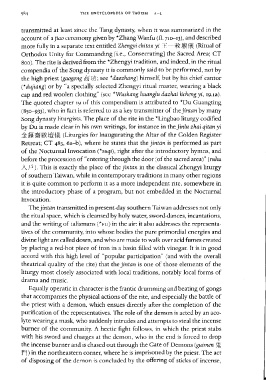Page 626 - The Encyclopedia of Taoism v1_A-L
P. 626
THE ENCYCLOPEDIA OF TAOISM A-L
transmitted at least since the Tang dynasty, when it was summarized in the
account of a jiao ceremony given by *Zhang Wanfu (ft. 710-13), and described
more fully in a separate text entitled Zhengyi chitan yi lE ~ \l& jf.l f~ (Ritual of
Orthodox Unity for Commanding [i.e., Consecrating] the Sacred Area; CT
800). The rite is derived from the *Zhengyi tradition, and indeed, in the ritual
compendia of the Song dynasty it is commonly said to be performed, not by
the high priest (gaogong r.'>j riJ; see *daozhang) himself, but by his chief cantor
(*dujiang) or by "a specially selected Zhengyi ritual master, wearing a black
cap and red woolen clothing" (see *Wushang huanglu dazhai licheng yi, 19.1a).
The quoted chapter 19 of this compendium is attributed to *Du Guangting
(850-933), who in fact is referred to as a key transmitter of the jintan by many
Song dynasty liturgists. The place of the rite in the *Lingbao liturgy codified
by Du is made clear in his own writings, for instance in the Jinlu zhai qitan yi
~ ff/; jW,f 1ilY::llrl fi (Liturgies for Inaugurating the Altar of the Golden Register
Retreat; CT 483, 6a-b) , where he states that the jintan is performed as part
of the Nocturnal Invocation (*suqi), right after the introductory hymns, and
before the procession of "entering through the door (of the sacred area)" (ruhu
A rs). This is exactly the place of the jintan in the classical Zhengyi liturgy
of southern Taiwan, while in contemporary traditions in many other regions
it is quite common to perform it as a more independent rite, somewhere in
the introductory phase of a program, but not embedded in the Nocturnal
Invocation.
The jintan transmitted in present-day southern Taiwan addresses not only
the ritual space, which is cleansed by holy water, sword-dances, incantations,
and the writing of talismans (*FU) in the air: it also addresses the representa-
tives of the community, into whose bodies the pure primordial energies and
divine light are called down, and who are made to walk over acid fumes created
by placing a red-hot piece of iron in a basin filled with vinegar. It is in good
accord with this high level of "popular participation" (and with the overall
theatrical quality of the rite) that the jintan is one of those elements of the
liturgy most closely associated with local traditions, notably local forms of
drama and music.
Equally operatic in character is the frantic drumming and beating of gongs
that accompanies the physical actions of the rite, and especially the battle of
the priest with a demon, which ensues directly after the completion of the
purification of the representatives. The role of the demon is acted by an aco-
lyte wearing a mask, who suddenly intrudes and attempts to steal the incense
burner of the community. A hectic fight follows, in which the priest stabs
the incense burner and is chased out through the Gate of Demons (guimen *
with his sword and charges at the demon, who in the end is forced to drop
r~) in the northeastern corner, where he is imprisoned by the priest. The act
of disposing of the demon is concluded by the offering of sticks of incense,

